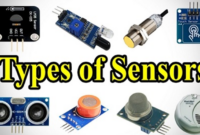Definition of LED (Light Emitting Diode) and How It Work – Light Emitting Diode or often abbreviated to LED is an electronic component that can emit monochromatic light when given forward voltage. LED is a family of diodes made of semiconductor materials. The color of light emitted by led depends on the type of semiconductor material they use. LED can also emit infrared light that is not visible to the eye as we often encounter on remote tv or remote control other electronic devices.
The shape of the LED is similar to a light bulb (light bulb) that is small and can be easily paired into various electronic devices. Unlike the Incandescent Lamp, LED do not require the burning of filaments so as not to cause heat in producing light. Therefore, currently LED (Light Emitting Diode) whose shape is small has been widely used as a light bulb in LCD TVs that replace tube lights.
Symbols and Shapes of LED (Light Emitting Diode)

How LED (Light Emitting Diodes) Work
As said earlier, LED is a family of diodes made of semiconductors. The way it works is almost the same as Diode which has two poles, namely the Positive Pole (P) and the Negative Pole (N). LED will only emit light when the forward voltage (forward bias) from the Anode to the Cathode.
LED consist of a semiconductor chip that is doping thus creating junctions P and N. What is meant by the doping process in semiconductors is the process of adding impurities (impurity) to a pure semiconductor resulting in the desired electrical characteristics. When the LED is fed by forward voltage or forward bias from the Anode (P) to the Cathode (K), the excess electrons in the N-Type material will move to the excess hole area that is a positively charged region (P-Type material). When an electron encounters a hole it releases a photon and emits monochromatic light (one color).

LED or Light Emitting Diodes that emit light when fed forward voltage can also be classified as Transducers that can convert Electrical Energy into Light Energy.
How to Know the Polarity of LED

To determine the polarity of the Anode (+) and Cathode (-) terminals on leDs. We can see it physically based on the picture above. The features of the Anode Terminal on LED is longer legs and also a smaller Lead Frame. While the characteristics of the Cathode Terminal are shorter legs with a large Lead Frame and located on the flat side.
LED colors (Light Emitting Diode)
Currently, LED have a variety of colors, including red, yellow, blue, white, green, orange and infrared. The color diversity in the LED depends on the wavelength and semiconductor compounds it uses. The following is a Table of Semiconductor Compounds used to produce color variations in LED:
| Semiconductor Materials | Wavelength | Color |
| Gallium Arsenide (GaAs) | 850-940nm | Infrared |
| Gallium Arsenide Phosphide (GaAsP) | 630-660nm | Red |
| Gallium Arsenide Phosphide (GaAsP) | 605-620nm | Orange |
| Gallium Arsenide Phosphide Nitride (GaAsP:N) | 585-595nm | Yellow |
| Aluminium Gallium Phosphide (AlGaP) | 550-570nm | Green |
| Silicon Carbide (SiC) | 430-505nm | Blue |
| Gallium Indium Nitride (GaInN) | 450nm | White |
Forward Voltage (Forward Bias) LED
Each LED Color (Light Emitting Diode) requires forward voltage (Forward Bias) to be able to power it. Forward Voltage for the LED is relatively low so it requires a resistor to limit the current and voltage so as not to damage the LED in question. Forward voltage is usually denoted by the sign VF.
| Color | Forward Voltage @20mA |
| Infrared | 1.2V |
| Red | 1.8V |
| Orange | 2.0V |
| Yellow | 2.2V |
| Green | 3.5V |
| Blue | 3.6V |
| White | 4.0V |
The Use of LED in Everyday Life
LED technology has various advantages such as not causing heat, durable, does not contain harmful materials such as mercury, and save electricity and its small shape is increasingly popular in the field of lighting technology. Various products that require light also adopt this Light Emitting Diode (LED) technology. Here are some of the applications of LEDs in everyday life.
- Home Lighting
- Street Lighting
- Advertising Board
- LCD backlight (TV, Mobile Display, Monitor)
- Interior and Exterior Decoration Lights
- Indicator Light
- InfraRed Transmitter on Remote Control (TV, AC, AV Player)
Read also Definition and Function of Zener Diode




